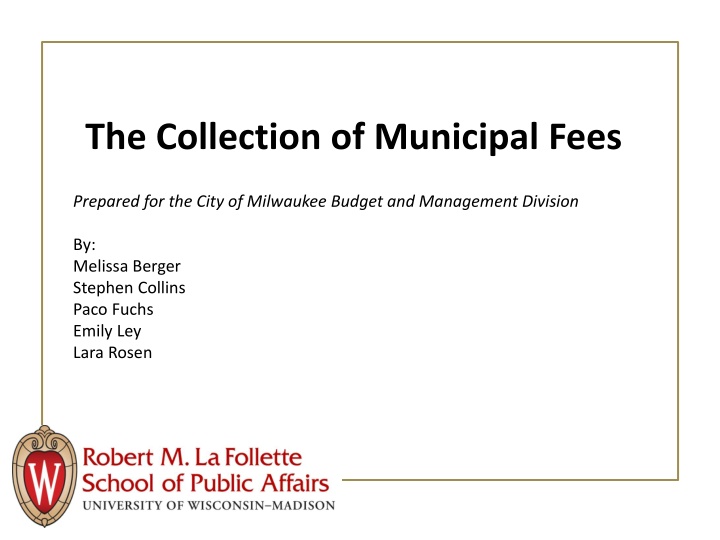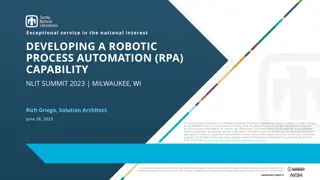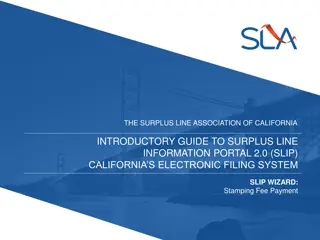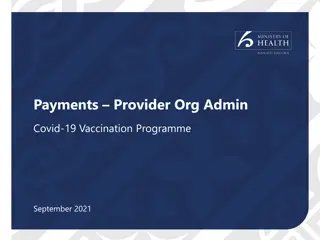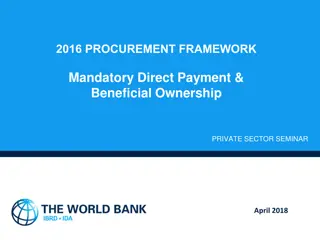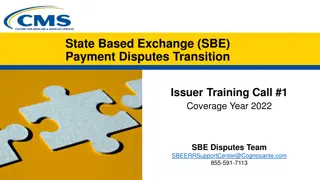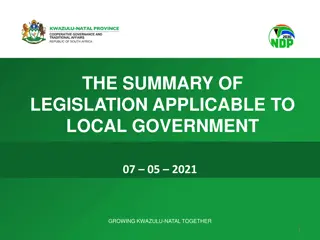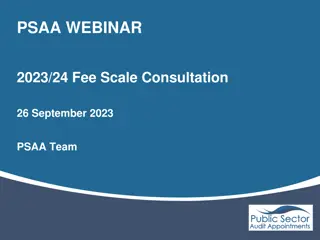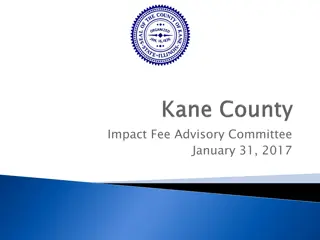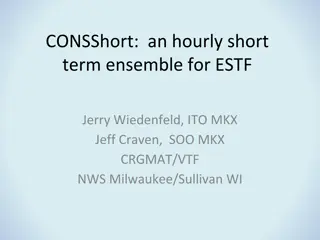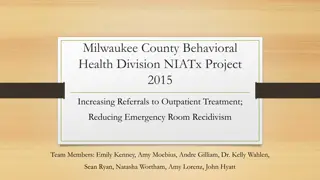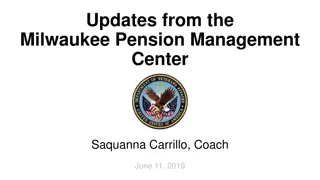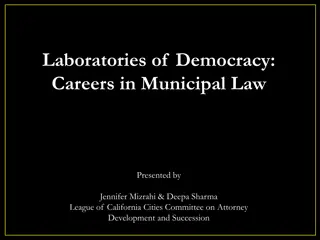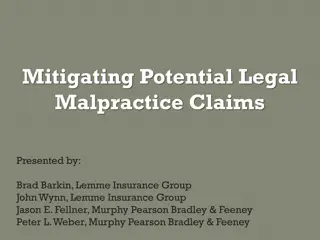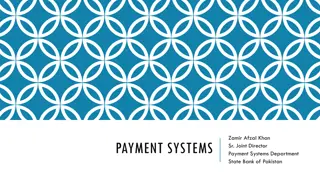Analyzing Municipal Fee Payment Trends in City of Milwaukee
The project focuses on the increasing share of unpaid property-related municipal fees in Milwaukee from 2007 to 2010, highlighting the financial implications and challenges faced by the city. Factors influencing fee payment behavior and key statistics are explored, offering policy options for further research and improvement. Different departments issuing fees, types of fees, property characteristics, and collection practices are analyzed to understand the dynamics affecting fee payment rates.
Download Presentation

Please find below an Image/Link to download the presentation.
The content on the website is provided AS IS for your information and personal use only. It may not be sold, licensed, or shared on other websites without obtaining consent from the author.If you encounter any issues during the download, it is possible that the publisher has removed the file from their server.
You are allowed to download the files provided on this website for personal or commercial use, subject to the condition that they are used lawfully. All files are the property of their respective owners.
The content on the website is provided AS IS for your information and personal use only. It may not be sold, licensed, or shared on other websites without obtaining consent from the author.
E N D
Presentation Transcript
The Collection of Municipal Fees Prepared for the City of Milwaukee Budget and Management Division By: Melissa Berger Stephen Collins Paco Fuchs Emily Ley Lara Rosen
Overview 1. What is the problem? 2. Which factors explain fee payment? 3. Statistical analysis 4. Policy options and suggestions for further research
Defining Municipal Fees and Special Charges Municipal Fees: Property-related fees issued for city services, utilities, and violations Special Charges: Municipal fees authorized by the Common Council to be added to owners property tax bills if unpaid
What is the Problem? Number of Special Charges 2004-2010 Total Dollar Value of Special Charges 2004-2010 45 140 40 120 35 Millions of Dollars (2010 dollars) 100 30 Thousands 80 25 20 60 15 40 10 20 5 0 0 2004 2005 2006 2007 Year 2008 2009 2010 2004 2005 2006 2007 Year 2008 2009 2010 Source: Calculated with data from the City of Milwaukee Assessor s Office
What is the Problem? An increasing share of Milwaukee s property-related municipal fees is not being paid in a timely fashion. From 17.3% in 2007 to 20.3% in 2010 Any delay in receiving payment is costly Debt service Lost interest revenue Outsourced collections Time and resources of staff to collect and track fees
Which factors explain fee payment? Characteristics of Fees Issuing department Fee type Fee anticipation Fee amount Characteristics of Properties Assessment class Assessed property value Owner occupancy Aldermanic district Characteristics of Collection Practices Billing notifications Late penalties Payment options
Characteristics of Fees Issuing departments Department of Neighborhood Services (DNS) Department of Public Works (DPW) Milwaukee Water Works (MWW) Type Utilities Minor Violations City Services Blight Fee anticipation Expected Unexpected Fee amount
Collection Rate Utilities 88.2% 82.8% 88.8% 90.9% 90.0% Municipal services Storm water Water Sewer Average Collections Rates by Fee Characteristic and Type, 2007-2010 Minor violations 18.3% 33.6% 11.2% 6.3% 28.3% 33.3% 17.4% 14.0% Garbage cart Building reinspection Tree removal / encroachments DNS misc- minor violations Snow removal Weed removal Health abatement (litter) City services 71.2% 28.2% 80.4% 55.0% 48.7% 0.0% 93.0% Bulky waste Special privilege Covered opening DNS misc- city services Fire prevention inspection Apartment garbage Source: Calculated with data from Milwaukee Water Works and the City s Departments of Neighborhood Services and Public Works Blight 5.3% 19.9% 49.2% 0.05% Building nuisance abatement Condemned building razing Police board ups
Characteristics of Fees Issuing departments Department of Neighborhood Services (DNS) Department of Public Works (DPW) Milwaukee Water Works (MWW) Type Utilities Minor Violations City Services Blight Fee anticipation Expected Unexpected Fee amount
Characteristics of Properties Comparing Properties in the City of Milwaukee and Properties with Special Charges Percentage of Properties per Assessment Class 2007-2010 Median Assessed Property Values 2007-2010 Mercantile Apartments (4+ units) Residential Commercial Other* Median Assessed Property Values 2007-2010 All Milwaukee Properties All Milwaukee Properties $115,375 79% 4% 3% 13% Properties with Minor Violation Charges Properties with Minor Violation Charges $88,125 82% 8% 7% 3% Properties with Blight Charges Properties with Blight Charges $77,225 81% 7% 7% 5% Properties with Delinquent Utility Charges Properties with Delinquent Utility Charges $98,125 89% 4% 4% 2% Properties with City Service Charges Properties with City Service Charges $314,450 51% 24% 13% 11% Source: Calculated with data from Milwaukee Water Works , the City s Departments of Neighborhood Services and Public Works, and Milwaukee s Master Property Record (MPROP)
Characteristics of Properties Owner-Occupancy 2007-2010 80% Percentage of Properties Classified as Owner-Occupied 70% 60% 50% All Milwaukee Properties Delinquent Utility Charges 40% Minor Violation Charges Blight Charges City Service Charges 30% 20% 10% 0% Source: Calculated with data from Milwaukee Water Works and the City s Departments of Neighborhood Services and Public Works, and Milwaukee s Master Property Record (MPROP)
Characteristics of Properties Total Value of Special Charges 2007-2010 by Aldermanic District Source: Calculated with data from Milwaukee Water Works , the City s Departments of Neighborhood Services and Public Works, and Milwaukee Master Property Record (MPROP)
Characteristics of Collection Billing notifications: type and frequency DNS: Some letters, some invoices sent once DPW: Invoices sent once (*one exception) MWW: Invoices sent quarterly Late penalties DNS: None DPW: $10 one time fee (*two exceptions) MWW: 5% and 3% compounded quarterly Payment types accepted DNS and DPW: Cash and check only MWW: Cash, Check, MasterCard, Discover, E-Check, AutoPay
Statistical Analysis Department of Public Works (DPW) Department of Neighborhood Services (DNS) About 140,000 observations Observations are individual municipal fees issued 2007-2010
Statistical Analysis Higher probability of payment Lower probability of payment Characteristics of fees Fee amount Condemned building razing fees Characteristics of properties Tax delinquency Owner occupancy Duplexes (relative to single- family properties) Multifamily properties (relative to single-family properties) Characteristics of collection None Characteristics of fees Increased expectedness Fire prevention permit fees Apartment garbage collection fees Characteristics of properties Assessed property value Owner living in Wisconsin Characteristics of collection Late penalties Expected invoices
Statistical Analysis Invoices: mostly positive increases in probability of payment Expected invoices to unexpected letters Residential: 25 percent increase Commercial: 41 percent increase Mercantile: 6 percent increase Other relationships varied (less data) Late penalties: large positive increases in probability of payment For both expected and unexpected fees Residential: 17 percent increase Commercial: 18 to 21 percent increase Mercantile: 29 percent increase
Three Key Policy Options 1. Mail invoices with due dates for all fees 2. Issue late penalties for all unpaid fees 3. Offer credit card payment options for all fees
Suggestions for Further Analysis 1. Trend Analysis 2. Cost-Effectiveness Analysis Prerequisites for Analyses: Improve data maintenance Require departments to register each billing and payment event for each fee issued Implement uniform coding protocol Collect detailed information on administrative costs
For further information Contact the La Follette School s publications office at 608-263-7657 or publications@lafollette.wisc.edu Or see www.lafollette.wisc.edu/publications/workshops.html Thank you
Data Interviews (January - April 2011) Departmental accounts receivable files (2007-2010) Master Property Record (2007-2010) Assessor data (2004-2010) Treasurer records (2007-2010)
Regression Methodology Multivariate probit regression model Dependent variable = 0 if the fee was placed on the property tax bill and = 1 if it was paid in full and not placed on the property tax bill Explanatory variables: characteristics of fees, properties, and collection practices. Add equation Departments of Neighborhood Services and Public Works data only
Regression Methodology 138,200 observations in 3 distinct categories: 1. residential properties (89,238) 2. mercantile apartments (23,628) 3. commercial properties (25,334) Divide by expected versus unexpected For each sample, we estimate the effects of billing type (invoices and letters) late penalty issuance
Process Departments collect a portion of municipal fees October: departments submit list of unpaid fees (now special charges) to Assessor for placement on tax bills December: Treasurer mails property tax bills If owners do not pay in January, City Attorney sends four warning letters, then employs Kohn Law Firm (KLF) to collect. If KLF cannot collect, City forecloses on property
